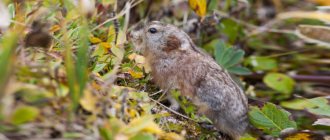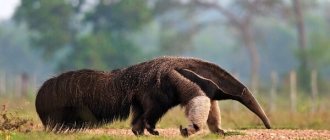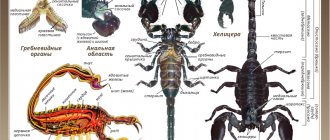It is not entirely clear why the weasel was called a weasel. After all, at its core, a small predator is a rather aggressive and ruthless animal. An incredibly flexible body, strong legs, keen eyes and a delicate sense of smell allow the weasel to easily find and catch up with prey even in the dark. And its small size does not at all prevent the animal from hunting larger game.
Some large predators are openly afraid of the elusive animal and avoid the weasel. But perhaps they just don’t want to waste time looking for a nimble baby.
general characteristics
The weasel is the smallest carnivorous mammal. The size of sexually mature animals rarely exceeds 115–260 mm, and the weight ranges from only 60–250 g.
The body of the animal is elongated and very flexible; its legs are quite short in comparison, but strong.
Due to their body structure, weasels move in small jumps or mince their paws finely. The paws have five toes with sharp claws, thanks to which the animals can move through trees.
The head is oblong, the ears are small and rounded. The eyes are small, the nose, depending on the color, can be dark brown, black or pinkish.
Elena
Ask a Question
Question to the expert
By what external signs can you distinguish a weasel from an ermine?
The animals are very similar in appearance, but the ermine, unlike the weasel, does not have a black tassel at the tip of its tail. Also, stoats are noticeably larger than weasels.
The tail of weasels is covered with uniform fur and, depending on the species, can reach a length of 7–15 cm. At the base of the tail there are glands that secrete a secretion with a rather unpleasant odor.
Body color greatly depends on the subspecies of animals. In the wild there are brown-brown, gray, sandy, red, black-and-white and snow-white animals. Body color can be monochromatic or zonal. Some subspecies have a lighter head, throat, belly and paws or are covered with white fur. Three varieties have white stripes on their backs.
Common weasels are dark brown or tan-brown in summer with a snow-white chest and belly. In winter, the animals change the color of their fur coat to snow-white. This camouflage allows the animals to remain unnoticed in the snow while hunting.
Habitat
The animals are distributed throughout North Asia, America and Europe. Weasels prefer to settle in places where small rodents gather, so they can be found both in the forest and in the steppe. Some representatives of the species prefer to settle in mountainous areas.
Weasels are cautious, but not cowardly, so they are often found near populated areas.
Small predators make shelters under tree roots, in hollows, burrows, and even in barns and sheds. They line the nest with grasses, leaves, moss, dry feathers and their own fur. In places rich in food, weasels live in small colonies.
Place of residence
Aquatic turtles - types, description, care and habitats
The animal's habitat is quite wide. The long-tailed weasel can be found in North and South America, the Amazonian weasel in Peru and Brazil, and the Colombian weasel in the highlands of Colombia. The white-striped weasel lives in Indochina and Nepal, the Patagonian weasel lives in Argentina and Chile, and the barefoot weasel lives in southeast Asia. You can determine where the North African weasel lives by its name.
There is a connection between the size and color of the animal and its habitat. Animals inhabiting the Far East, northern regions of Europe, North America and Siberia are small in size and have dark hair, while those living in the arid regions of Asia are larger and lighter in color.
The place where a predator can be found is determined by the amount of food. The animal likes to live close to an abundance of rodents, which often leads it to city parks, farmland and village houses.
The common weasel lives on the territory of our country. It is found in the tundra, forest-tundra, steppe zone, in arid and wetlands, in general, almost everywhere, with the exception of the polar region and high mountains.
The weasel animal uses burrows of exterminated rodents and old hollows to live, climbs into inter-root spaces and under stones, and is not afraid to settle in barns. The animal lines its place of residence with grass, moss and dry leaves.
Little predator lives in burrows
As a rule, a predator has several shelters. The place where the weasel lives, which occupies up to 10 hectares, is marked with a special liquid. An unpleasant smell scares away enemies and competitors. The hunting areas of the female and male may overlap. Individuals of the same sex never occupy common space.
During wintering, the animal does not leave its territory, hunting for mice in the thickness of the snowdrifts. If there is an abundance of rodents in the snow voids, the predator may not come to the surface for a long time. Lack of food forces the weasel to leave their lands and look for new ones.
For your information! Due to urban development and park landscaping, the animal has to leave its habitat. So, in 2001, the weasel was listed in the Red Book of Moscow.
What do weasels eat?
Weasel is a very dexterous and sneaky predator. The structure of the body allows it to crawl into the narrowest holes. The animal has a very flexible body and if the head gets through, the whole animal will get through. The little weasel is very brave and fearlessly rushes at prey that is several times its size. It is almost impossible to hide from an agile predator, since nature has endowed weasels with a keen sense of smell, keen hearing and keen eyes.
The basis of the weasel's diet is voles, but it also happily eats other small animals and birds.
Recommended by topic
Fox Panda Lynx
Diet:
- forest and field mice;
- bunnies;
- shrews;
- small snakes;
- moles;
- lizards;
- rats;
- jerboas;
- prairie dogs;
- chicks, eggs;
- hamsters;
- insects;
- Domestic bird;
- frogs.
Some subspecies happily eat shellfish, fish, and also feed on kitchen waste.
In a year, one individual can exterminate up to two hundred mice, and with an abundance of food, store from 20 to 50 rodents for future use.
When the weasel overtakes the victim, it bites through the base of the skull and quickly eats all the soft parts of the carcass. First, she eats the insides and only then starts eating the meat.
After a successful hunt, the weasel drags the prey into its hole and eats it on the spot. The animal is not stopped by the distance and the weight of the carcass, which can exceed its own by several times.
Nutrition
what the weasel animal eats . Its diet includes all representatives of mouse-like rodents. With great appetite she eats mice, rats, shrews and moles.
The weasel loves birds and rabbits very much. She will never refuse to make a hole in an egg and drink all its contents. When an animal does not have enough food, the weasel does not disdain snakes, lizards, small fish and other amphibians.
He prefers to store food for himself for future use. You can often find at least 30 mice in a weasel's home. The weasel's method of neutralizing its victim practically does not change; it sinks its sharp teeth into the victim's neck. It is very difficult to break up such a fight.
Reproduction and raising of offspring
The reproduction of weasels directly depends on the abundance of food. The process itself and the exact timing have not yet been studied, since the animals are very secretive. Animals reach sexual maturity at approximately 1–2 years.
Mating season
The mating season, as a rule, begins with the arrival of warm weather. But the activity of predators depends on the number of rodents, which are the main component of their diet. After rodents leave their winter shelters, weasels begin breeding season. The abundance of food activates the biorhythms of predators.
During the rutting season, the male covers several females who live in adjacent territories. The exact numbers and timing of mating have not been established.
Scientists have found that females aged 1 to 3 years can bear offspring throughout the year. That is, mating can take place several times during the warm season. In older females, estrus occurs once in the spring.
Duration of pregnancy and childbirth
On average, weasel pregnancy lasts from 30 to 36 days. Most babies are born in April or May. But during periods of famine, the fertilized egg may freeze until next spring. Such mechanisms help the female survive and preserve future offspring.
In well-fed years, females can give birth to 2 or 3 litters. There are cases when hunters found babies in summer and even winter.
Before the birth of the babies, the female builds a cozy nest in mouse holes, abandoned hollows or crevices. It often happens that the female drives out or simply eats the residents. The weasel lines the bottom of the maternity compartment with soft grass, hay, down and feathers.
Weasels do not dig holes because their paws and claws are not designed for digging.
Recommended by topic
Deer Kite Woodpecker
Babies are born bald, deaf and blind. A litter can contain from 4 to 6, less often from 1 to 9 cubs, whose weight rarely exceeds 1.5 g.
After 4–6 days, the puppies become overgrown with baby fur, and after another 7–10 days, their eyes open and their baby teeth begin to cut. From about four weeks of age, babies react to danger and extraneous sounds with amusing tsking and hissing. When little weasels are afraid, the smell of the anal glands intensifies.
Up to one and a half months, babies feed only on mother's milk. Closer to two months of age, the female begins to bring prey for the cubs, and they taste fresh meat for the first time. The female tears the dense skin so that the babies can get to the flesh. From 5–6 weeks, babies can already deal with the prey they bring on their own, and from 7–8 weeks of age they try to hunt with their mother.
Caring for the Cubs
Weasels are very caring mothers. They can spend hours licking and playing with their young. Males do not take part in raising offspring.
If threatened, the female grabs the babies by the scruff of the neck and carries them to a secluded place. First of all, the mother tries to save the largest, and therefore promising, baby and only then returns with the rest.
The babies spend the first few weeks in a hole near their mother. The cubs begin to come out only after they have become stronger, covered with fur and stand firmly on their feet. They follow their mother everywhere, learn to hide and steal prey.
Grown-up babies leave the nest at the age of 3 to 4 months. At first, they do not go far from the mother’s site and only after six months they gradually move to a new place.
In colonies, babies may not leave the maternity nest for up to six months. Later they settle next to their parents and often spend their lives side by side.
Natural enemies
Despite the courage and courage of the little weasel, almost all predators hunt it. But not all animals, having driven a weasel into a corner, decide to attack it. Hunters and naturalists tell stories of small and fearless animals tearing out the throats of birds of prey right in the air.
Natural enemies:
- fox;
- wolf;
- lynx;
- large snakes;
- owls, eagle owls, tawny owls;
- eagles, golden eagles, hawks;
- martens, ferrets;
- badgers;
- wild and domestic dogs;
- cats;
- raccoon dogs.
It is almost impossible to take a weasel by surprise; the reaction speed of adult animals is simply amazing. Therefore, adults die quite rarely; usually babies, sick, weakened or old animals fall into the clutches of predators.
The main threat to the population comes from humans. Weasel fur and meat do not provide any commercial value, but constantly growing cities, fields and roads are reducing suitable habitat. Animals also often die in traps for larger game and are poisoned by rat and mouse poison.
This is a pet at home
Of course, weasels can be kept at home, but this is done extremely rarely, since taming a baby is quite a task. In essence, you can tame this predator only if you raise it from birth. And even under this condition, the taming process will not be simple.
But if we assume that this worked out, then initially for petting it is necessary to purchase a very spacious cage with different levels and equipped with everything that an animal might need for life.
Weasel on a woodpecker
The most important thing in keeping this baby at home is organizing the right diet. It should not have significant differences from the natural one, therefore, in addition to the usual eggs, meat and fish, the diet should be diluted with special mixtures that are sold in pet stores. On average, an animal should eat 50 grams of food.
Interesting Facts
Weasels still have the status of not fully studied animals, as they lead a very secretive lifestyle. Every year information about animals is updated. And in little-studied areas, scientists find new species that are difficult to classify due to lack of data.
Interesting Facts:
- Weasels are the smallest members of the family of carnivorous mammals.
- Small animals are always hungry due to their increased metabolism. Gluttonous animals need to constantly eat in order not to lose weight.
- If weasels drive their prey “into a corner,” they perform a kind of dance, which consists of jumping, dashing and pouncing. This behavior distracts and exhausts the victim to the point that he cannot resist.
- Weasels are solitary animals and form pairs only during the mating season. But in areas with a rich food supply, animals can form colonies.
- Representatives of the family easily adapt to climate and other natural factors, so they can survive in almost any area. The main condition is a good food supply.
- Male weasels regularly walk around their property, which can reach 8 hectares, and drive out competitors.
- The animals are excellent at climbing trees and mountain slopes, and are also excellent swimmers.
- In search of food, weasels can travel two kilometers in one night.
- Small predators make supplies from killed mice.
- Surprisingly, weasels are quite silent. The only sounds are hissing during fights and quiet hooting during mating games and communication with babies.
- The more food, the more offspring. In well-fed years, females can produce 2 to 3 litters per season.
- Pregnancy may be delayed. During lean periods, an egg fertilized in early summer may delay development until the following spring.
The Greeks believed that snow-white caresses were unhappy brides who were betrayed at the altar. The appearance of an animal near the house was considered a bad omen. And in North American Indians they reacted to affection like Russians to a black cat. If an animal crossed a person’s path, then he was promised troubles and misfortunes.











